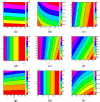Impact of social media advertisements on the transmission dynamics of COVID-19 pandemic in India
- PMID: 33679275
- PMCID: PMC7910777
- DOI: 10.1007/s12190-021-01507-y
Impact of social media advertisements on the transmission dynamics of COVID-19 pandemic in India
Abstract
In this paper, we propose a mathematical model to assess the impact of social media advertisements in combating the coronavirus pandemic in India. We assume that dissemination of awareness among susceptible individuals modifies public attitudes and behaviours towards this contagious disease which results in reducing the chance of contact with the coronavirus and hence decreasing the disease transmission. Moreover, the individual's behavioral response in the presence of global information campaigns accelerate the rate of hospitalization of symptomatic individuals and also encourage the asymptomatic individuals for conducting health protocols, such as self-isolation, social distancing, etc. We calibrate the proposed model with the cumulative confirmed COVID-19 cases for the Republic of India. We estimate eight epidemiologically important parameters, and also the size of basic reproduction number for India. We find that the basic reproduction number for India is greater than unity, which represents the substantial outbreak of COVID-19 in the country. Sophisticated techniques of sensitivity analysis are employed to determine the impacts of model parameters on basic reproduction number and symptomatic infected population. Our results reveal that to reduce disease burden in India, non-pharmaceutical interventions strategies should be implemented effectively to decrease basic reproduction number below unity. Continuous propagation of awareness through the internet and social media platforms should be regularly circulated by the health authorities/government officials for hospitalization of symptomatic individuals and quarantine of asymptomatic individuals to control the prevalence of disease in India.
Keywords: COVID-19; Epidemic model; Estimation; Future pandemic; Global stability; Sensitivity analysis; Social media advertisements.
© Korean Society for Informatics and Computational Applied Mathematics 2021.
Conflict of interest statement
Conflict of interestThe authors declare that they have no conflicts of interest.
Figures









Similar articles
-
A mathematical model for the impacts of face mask, hospitalization and quarantine on the dynamics of COVID-19 in India: deterministic vs. stochastic.Math Biosci Eng. 2020 Nov 26;18(1):182-213. doi: 10.3934/mbe.2021010. Math Biosci Eng. 2020. PMID: 33525087
-
Dynamics of coronavirus pandemic: effects of community awareness and global information campaigns.Eur Phys J Plus. 2021;136(10):994. doi: 10.1140/epjp/s13360-021-01997-6. Epub 2021 Oct 4. Eur Phys J Plus. 2021. PMID: 34631341 Free PMC article.
-
Modeling the impact of non-pharmaceutical interventions on the dynamics of novel coronavirus with optimal control analysis with a case study.Chaos Solitons Fractals. 2020 Oct;139:110075. doi: 10.1016/j.chaos.2020.110075. Epub 2020 Jul 3. Chaos Solitons Fractals. 2020. PMID: 32834618 Free PMC article.
-
Quarantine alone or in combination with other public health measures to control COVID-19: a rapid review.Cochrane Database Syst Rev. 2020 Sep 15;9(9):CD013574. doi: 10.1002/14651858.CD013574.pub2. Cochrane Database Syst Rev. 2020. PMID: 33959956 Free PMC article.
-
An overview of mobile applications (apps) to support the coronavirus disease 2019 response in India.Indian J Med Res. 2020 May;151(5):468-473. doi: 10.4103/ijmr.IJMR_1200_20. Indian J Med Res. 2020. PMID: 32474557 Free PMC article.
Cited by
-
Assessing the effectiveness of the intervention measures of COVID-19 in China based on dynamical method.Infect Dis Model. 2023 Mar;8(1):159-171. doi: 10.1016/j.idm.2022.12.007. Epub 2023 Jan 5. Infect Dis Model. 2023. PMID: 36624814 Free PMC article.
-
Mathematical COVID-19 model with vaccination: a case study in Saudi Arabia.PeerJ Comput Sci. 2022 May 13;8:e959. doi: 10.7717/peerj-cs.959. eCollection 2022. PeerJ Comput Sci. 2022. PMID: 35634103 Free PMC article.
-
COVID-19 Critical Care Simulations: An International Cross-Sectional Survey.Front Public Health. 2021 Sep 21;9:700769. doi: 10.3389/fpubh.2021.700769. eCollection 2021. Front Public Health. 2021. PMID: 34631644 Free PMC article.
-
The relationship between compartment models and their stochastic counterparts: A comparative study with examples of the COVID-19 epidemic modeling.J Biomed Res. 2024 Mar 5;38(2):175-188. doi: 10.7555/JBR.37.20230137. J Biomed Res. 2024. PMID: 38438134 Free PMC article.
-
A review on the induction of host immunity by the current COVID-19 vaccines and a brief non-pharmaceutical intervention to mitigate the pandemic.Bull Natl Res Cent. 2022;46(1):31. doi: 10.1186/s42269-022-00719-x. Epub 2022 Feb 16. Bull Natl Res Cent. 2022. PMID: 35194369 Free PMC article. Review.
References
-
- World Health Organization, Situation report. https://www.who.int/emergencies/diseases/novel-coronavirus-2019/situatio... (2020)
-
- McKee M, Stuckler D. If the world fails to protect the economy, COVID-19 will damage health not just now but also in the future. Nat. Med. 2020;26:640–642. - PubMed
-
- Misra AK, Rai RK, Takeuchi Y. Modeling the control of infectious diseases: effects of TV and social media advertisements. Math. Biosci. Eng. 2018;15(6):1315–1343. - PubMed
LinkOut - more resources
Full Text Sources
Other Literature Sources
